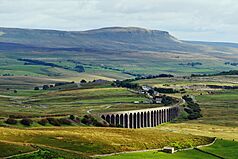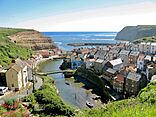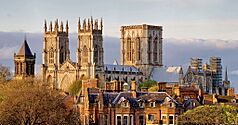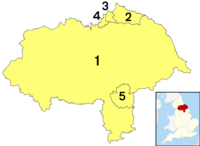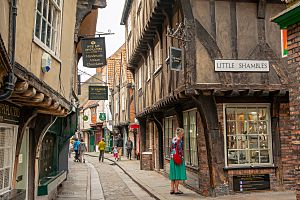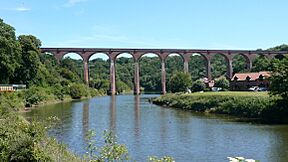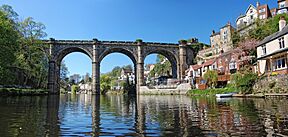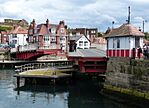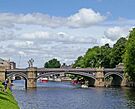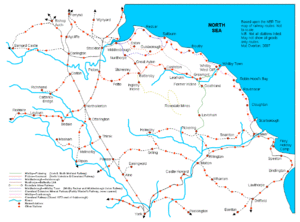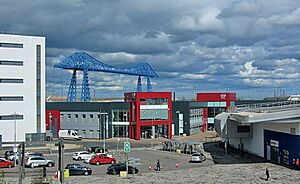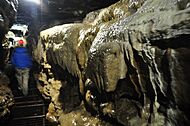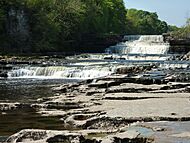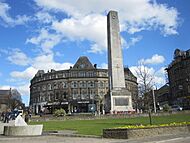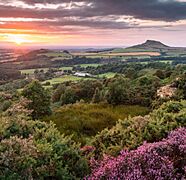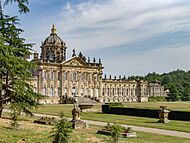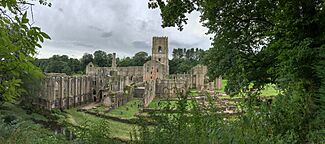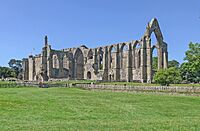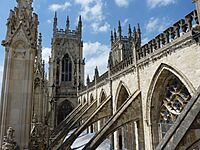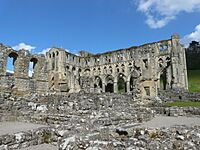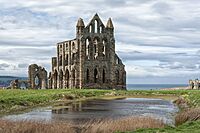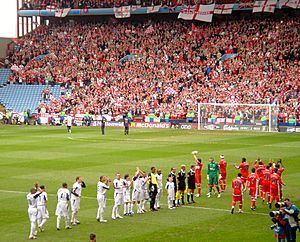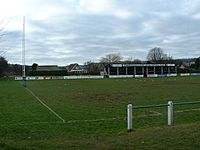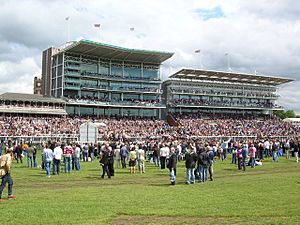North Yorkshire facts for kids
Quick facts for kids
North Yorkshire
|
|||||||||||||||||||||||||||||
|---|---|---|---|---|---|---|---|---|---|---|---|---|---|---|---|---|---|---|---|---|---|---|---|---|---|---|---|---|---|
|
Top to bottom, left to right: Ribblehead Viaduct in the Yorkshire Dales, the Tees Transporter Bridge in Middlesbrough, Staithes, and York Minster
|
|||||||||||||||||||||||||||||
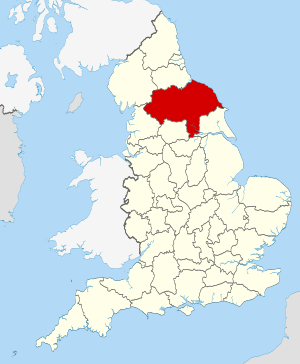
Location of North Yorkshire within England
|
|||||||||||||||||||||||||||||
| Sovereign state | United Kingdom | ||||||||||||||||||||||||||||
| Constituent country | England | ||||||||||||||||||||||||||||
| Region | Yorkshire and the Humber and North East | ||||||||||||||||||||||||||||
| Established | 1974 | ||||||||||||||||||||||||||||
| Established by | Local Government Act 1972 | ||||||||||||||||||||||||||||
| Origin | Yorkshire | ||||||||||||||||||||||||||||
| Time zone | UTC±00:00 (Greenwich Mean Time) | ||||||||||||||||||||||||||||
| • Summer (DST) | UTC+01:00 (British Summer Time) | ||||||||||||||||||||||||||||
| Members of Parliament | List of MPs | ||||||||||||||||||||||||||||
| Police | North Yorkshire Police Cleveland Police |
||||||||||||||||||||||||||||
| Largest town | Middlesbrough | ||||||||||||||||||||||||||||
|
|||||||||||||||||||||||||||||
North Yorkshire is a large county in England. It's located in the Yorkshire and the Humber and North East regions. It shares borders with County Durham to the north and the North Sea to the east. To the south, it meets the East Riding of Yorkshire, South Yorkshire, and West Yorkshire. To the west, it borders Cumbria and Lancashire.
Northallerton is the main town of the county. North Yorkshire is the biggest county in England by land area, covering about 8,654 square kilometers (3,341 square miles). In 2021, over 1.1 million people lived here. The largest towns are Middlesbrough and the historic city of York. Other big towns include Harrogate and Scarborough.
Most of North Yorkshire is countryside. It has beautiful natural areas like the North York Moors and the Yorkshire Dales. Many rivers flow through the county, including the River Ouse. The highest point in North Yorkshire is Whernside, a mountain that is 736 meters (2,415 feet) tall.
Contents
- History of North Yorkshire
- Exploring North Yorkshire's Geography
- How North Yorkshire is Governed
- North Yorkshire's Economy
- Getting Around North Yorkshire
- Education in North Yorkshire
- Fun Places to Visit in North Yorkshire
- News and Media in North Yorkshire
- Sport in North Yorkshire
- Images for kids
- See also
History of North Yorkshire
North Yorkshire was created on April 1, 1974. This happened because of a law called the Local Government Act 1972. It took parts from older areas like the North Riding, West Riding, and East Riding of Yorkshire. The city of York also became part of it.
Northallerton was chosen as the county town, just like it used to be for the North Riding. From 1974 to 1996, the county was divided into eight smaller areas called districts.
In 1996, some changes happened. Areas like Middlesbrough and Redcar and Cleveland became separate areas that manage themselves. They are still part of North Yorkshire for ceremonial reasons. The city of York also became a self-governing area.
More recently, on April 1, 2023, the main part of North Yorkshire became a single, large self-governing area. This means it now handles all local services for its residents.
Exploring North Yorkshire's Geography
North Yorkshire's landscape is shaped by its rocks and landforms. It is home to two amazing national parks: the North York Moors and most of the Yorkshire Dales. These are special places protected for their natural beauty.
The highest point in the county is Whernside, which is 736 meters (2,415 feet) tall. Another unique hill in the northeast is Roseberry Topping.
Rivers of North Yorkshire
North Yorkshire has many important rivers. The River Tees flows along the northern border with County Durham and reaches the North Sea. Many rivers start in the Yorkshire Dales, including the Aire, Swale, and Wharfe.
These rivers eventually join the Ure, which then becomes the River Ouse. The Ouse is one of the longest rivers in the UK. It flows south and eventually reaches the Humber estuary. The North York Moors also have rivers like the Esk, which flows directly into the North Sea at Whitby.
Green Spaces and Protected Areas
North Yorkshire has special "green belt" areas. These are protected lands around cities like Leeds and York. They help stop towns from growing into each other and keep the countryside open.
The green belt also connects to the Yorkshire Dales National Park and the Nidderdale AONB, which is another beautiful protected area.
North Yorkshire's Climate
North Yorkshire has a temperate oceanic climate, which means it has mild temperatures and rain throughout the year, like most of the UK. However, the weather can change a lot depending on where you are in the county.
The higher parts of the Pennines can feel almost subarctic, with colder temperatures. In contrast, the Vale of Mowbray can be quite dry, almost like a semi-arid area.
Overall, North Yorkshire gets less rain than many other parts of the UK. Summers are usually warm, with temperatures often reaching 22°C (72°F) and sometimes even hotter during heat waves. Winters are colder, with average lows around 1°C (34°F). Snow is common in the North York Moors and Pennines, staying on the ground for many days each year. The coast gets the most sunshine.
| Climate data for North Yorkshire | |||||||||||||
|---|---|---|---|---|---|---|---|---|---|---|---|---|---|
| Month | Jan | Feb | Mar | Apr | May | Jun | Jul | Aug | Sep | Oct | Nov | Dec | Year |
| Record high °C (°F) | 15 (59) |
17 (63) |
21 (70) |
24 (75) |
29 (84) |
32 (90) |
40 (104) |
33 (91) |
29 (84) |
28 (82) |
19 (66) |
16 (61) |
40 (104) |
| Mean daily maximum °C (°F) | 6 (43) |
7 (45) |
10 (50) |
13 (55) |
16 (61) |
19 (66) |
22 (72) |
22 (72) |
18 (64) |
14 (57) |
10 (50) |
7 (45) |
14 (57) |
| Mean daily minimum °C (°F) | 1 (34) |
1 (34) |
2 (36) |
4 (39) |
7 (45) |
10 (50) |
12 (54) |
12 (54) |
10 (50) |
7 (45) |
4 (39) |
1 (34) |
6 (43) |
| Record low °C (°F) | −14 (7) |
−10 (14) |
−13 (9) |
−3 (27) |
−1 (30) |
2 (36) |
5 (41) |
4 (39) |
−1 (30) |
−7 (19) |
−14 (7) |
−19 (−2) |
−19 (−2) |
| Average precipitation mm (inches) | 40 (1.6) |
35 (1.4) |
43 (1.7) |
46 (1.8) |
42 (1.7) |
47 (1.9) |
51 (2.0) |
59 (2.3) |
53 (2.1) |
62 (2.4) |
56 (2.2) |
59 (2.3) |
593 (23.3) |
How North Yorkshire is Governed
North Yorkshire is governed by different councils. The main part of the county is managed by the North Yorkshire Council. Other areas like York, Middlesbrough, and Redcar and Cleveland have their own councils. These are called unitary authorities because they handle all local services.
Working Together: Combined Authorities

The councils in York and North Yorkshire have teamed up to form the York and North Yorkshire Combined Authority. This group helps make big decisions for the area. They even have a mayor who is elected by the people.
Another group is the Tees Valley Combined Authority. This includes Middlesbrough and Redcar and Cleveland from North Yorkshire, plus other towns from County Durham. They work together to improve the economy and transport in their area.
North Yorkshire's Economy
In many parts of North Yorkshire, farming is a very important job. About 85% of the county is considered "rural," meaning it's countryside.
Other jobs include making things (manufacturing) and working in hotels and restaurants, especially for tourists. Food production is also a big industry.
Tourism in North Yorkshire
Tourism is a huge part of North Yorkshire's economy. Many people visit the North York Moors and the Yorkshire Dales national parks every year. These visitors spend money on hotels, food, and activities, which helps create jobs for local people.
York is a very popular city for tourists. It attracts millions of visitors each year who come to see its historic sites and enjoy its atmosphere. York has even been ranked as one of the best cities to visit in the UK!
Jobs and Housing
North Yorkshire usually has a healthy economy with many different types of jobs. However, like many places, it was affected by the recent global events that caused some job losses. The government has tried to help businesses during these times.
The average house price in North Yorkshire is around £240,000. However, prices can be higher in popular towns like Harrogate and Ripon.
Getting Around North Yorkshire
Bridges of North Yorkshire
North Yorkshire has many interesting bridges. Some are for roads, some for trains, and some are just for people walking. The Tees Transporter Bridge, built in 1911, is a famous landmark in Teesside. It's one of the few working transporter bridges left in the world!
The Larpool Viaduct near Whitby used to be a railway bridge. Now, it's a path for walkers and cyclists, offering great views.
Train Travel in North Yorkshire
The East Coast Main Line is a major railway line that runs through North Yorkshire, stopping at Northallerton, Thirsk, and York. You can catch trains to London and other big cities from these stations.
Northern operates many local train lines across the county. These include routes to Scarborough, Whitby, and through the beautiful Yorkshire Dales.
Sadly, many railway lines in North Yorkshire were closed in the 1960s. However, some old lines have been brought back to life as Heritage railways. The North Yorkshire Moors Railway is a popular one, where you can ride on old steam trains.
York railway station is the biggest station in the county. It's right next to the National Railway Museum, which is a fantastic place to visit if you love trains!
Roads and Buses
The main road through North Yorkshire is the A1(M), which is a major motorway connecting the north and south of England. Other important roads include the A19 and A64.
You can also travel around North Yorkshire by coach and bus. Companies like National Express offer long-distance trips, while local bus companies help you get around towns and villages.
Airports Near North Yorkshire
North Yorkshire doesn't have its own major airport. However, there are several airports nearby that you can use, such as Teesside International Airport, Newcastle International Airport, and Leeds Bradford Airport.
Education in North Yorkshire
North Yorkshire has several universities and colleges where students can continue their education after school.
Universities
- Teesside University has its main campus in Middlesbrough.
- University of York and York St John University are both located in the city of York.
- There are also smaller campuses like CU Scarborough (part of Coventry University) and Queen's Campus, Durham University in Thornaby-on-Tees.
Colleges
North Yorkshire has many colleges that offer different courses, including:
- Askham Bryan College (for agriculture and land-based studies)
- Craven College in Skipton
- Middlesbrough College
- The Northern School of Art in Middlesbrough
- Scarborough Sixth Form College
- York College
Fun Places to Visit in North Yorkshire
| Key | |
| Owned by the National Trust | |
| Owned by English Heritage | |
| Owned by the Forestry Commission | |
| A Country Park | |
| An Accessible open space | |
| Museum (free) | |
| Museum (charges entry fee) | |
| Heritage railway | |
| Historic House | |
There are so many exciting places to explore in North Yorkshire!
- Brimham Rocks – amazing rock formations you can climb on.
- Castle Howard – a beautiful stately home with huge gardens.
- Eden Camp Museum – a museum about World War II, set in an old prisoner-of-war camp.
- Flamingo Land Theme Park and Zoo – a fun theme park with rollercoasters and a zoo.
- Jorvik Viking Centre in York – travel back in time to see what Viking York was like.
- Lightwater Valley – another exciting theme park.
- National Railway Museum in York – home to famous trains and railway history.
- North Yorkshire Moors Railway – ride a steam train through stunning scenery.
- Skipton Castle – a well-preserved medieval castle.
- Studley Royal Park – a beautiful water garden and deer park, home to Fountains Abbey.
- Tees Transporter Bridge – a unique bridge you can ride across.
- York Castle Museum – discover the history of everyday life in York.
-
White Scar Cave is a popular show cave in Chapel-le-Dale.
-
Aysgarth Falls, a popular destination in the Yorkshire Dales National Park for hikers, can also be reached by a short walk from the main road.
-
Harrogate is also a popular tourist destination, famous for its Victorian Turkish baths, gastronomy and high-end shops. The picture is of the Cenotaph.
-
Roseberry Topping in the North York Moors
Historic Religious Sites
North Yorkshire has many old and beautiful religious buildings:
- Bolton Abbey – ruins of an Augustinian monastery in a scenic spot.
- Fountains Abbey – one of the largest and best-preserved ruined monasteries in England.
- Rievaulx Abbey – another impressive ruined abbey.
- Ripon Cathedral – a stunning cathedral with a long history.
- Selby Abbey – a large and beautiful abbey church.
- Whitby Abbey – famous ruins on a clifftop, linked to the story of Dracula.
- York Minster – a magnificent cathedral, one of the largest in Northern Europe.
-
In terms of interior floor area, York Minster is the 3rd Largest Cathedral in the United Kingdom.
-
With the first monastery built in the 7th century, the ruins of the medieval Whitby Abbey still stand today, now famous for its role in Dracula.
Coastal Fun: Seaside Towns


North Yorkshire's coast is full of charming seaside towns:
- Filey – a lovely traditional resort.
- Redcar – a coastal town with a long sandy beach.
- Robin Hood's Bay – a picturesque fishing village with narrow streets.
- Scarborough – a popular resort with two bays, a castle, and funiculars.
- Saltburn – known for its cliff lift, pier, and miniature railway.
- Staithes – a charming old fishing village.
- Whitby – famous for its abbey, Captain Cook connections, and 199 steps.
News and Media in North Yorkshire
People in North Yorkshire get their TV and radio from different places. Depending on where you live, you might receive BBC and ITV channels for Yorkshire, or for the North East and Cumbria. Some areas in the west get channels from Lancashire.
Sport in North Yorkshire
North Yorkshire is a great place for sports fans!
Cricket
Yorkshire County Cricket Club plays some of its matches in Scarborough.
Football
North Yorkshire has many football clubs:
- Harrogate Town
- Middlesbrough
- Scarborough Athletic
- Whitby Town
- York City
Middlesbrough is the highest-ranked team, playing in the EFL Championship. They have even won the EFL Cup and reached a European final! Harrogate Town and York City also play in professional leagues.
Rugby
Rugby is also popular, with teams like Wharfedale RUFC and Harrogate RUFC playing in rugby union leagues. For rugby league, York Knights and York Valkyrie represent the county.
Racing
If you like racing, North Yorkshire has several racecourses for horse racing, including York Racecourse, which is very famous. There's also Croft Circuit for motor racing and Oliver's Mount for motorcycle racing.
Images for kids
See also
 In Spanish: Yorkshire del Norte para niños
In Spanish: Yorkshire del Norte para niños


